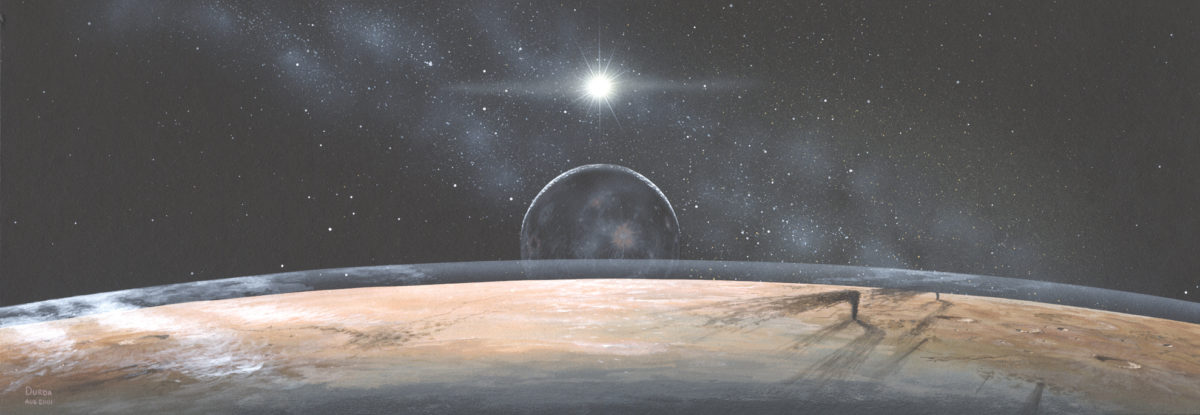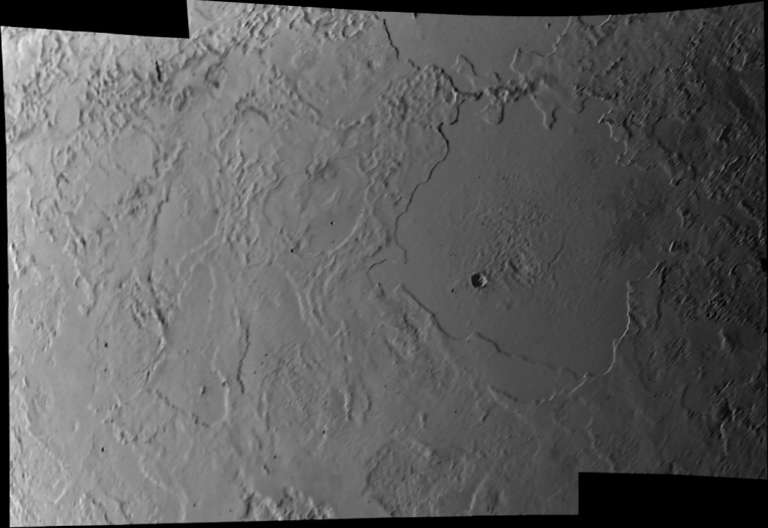Emily Lakdawalla • Aug 02, 2013
Pluto on the Eve of Exploration by New Horizons: Is there an ocean, or not?
Does Pluto have an ocean under its ice? If it doesn't now, did it ever have one? How will we know? After spending three days last week at the "Pluto on the Eve of Exploration by New Horizons" conference, I've concluded that the subsurface ocean question is central to everything that we don't know yet about Pluto's geology. There's one more important, related question: after the New Horizons encounter, will we be able to say for certain whether it has or ever had an ocean?
We'll have to wait and see!

You might be wondering how Pluto -- so (relatively) small and so distant from the Sun -- could ever have gotten hot enough for even some of its ice to melt. Certainly its crust is as hard and as brittle as rock, and always has been. The question is whether anything ever heated its insides enough to melt a deep layer of ice into water.
There are three main ways to melt something so far from the Sun. The first would've had to take place very early in the formation of the solar system. If Pluto formed very rapidly, it would've incorporated a large enough quantity of short-lived radioactive elements for their rapid decay to generate heat more rapidly than it could radiate away. The isotope aluminum-26 is particularly important to the early lives of the outer solar system's icy worlds; fast formation and the presence of aluminum-26 has been invoked to explain early melting of Saturn's moons. Even if Pluto's aluminum-26 didn't make it hot enough to melt, radioactive decay surely would've imparted a boost to its temperature.
Then, of course, there are impacts, which transform a chunk of the kinetic energy of a round world into heat. The impact between the proto-Earth and the proto-Moon, and the Moon's subsequent condensation, were accompanied by so much heat that much of the Moon melted. But impacts at Pluto's distance from the Sun happen between cold bodies with low density that aren't moving very fast (at least, not compared to the Earth-Moon impact), and Robin Canup demonstrated in a talk that I missed on Tuesday that the impact that formed the Pluto-Charon system could've happened without either body ever melting. Still, that's another energy boost.
There's one more way to generate heat: the geophysics of tides. Two bodies that orbit each other raise tides -- gravitational bulges -- on each other's surfaces. If the orbits are not circular, or if the orbiting bodies rotate at a different speed than they dance around each other, the tidal bulges will move around the moving worlds. Changing the shape of a solid world takes a tremendous amount of energy, energy that gets dissipated as heat. Eventually, friction slowed the rotation of both Pluto and Charon, and increased their distance from each other, until they kept the same faces pointed at each other in mutually circular orbits. So at present, there's no energy being generated in Pluto or Charon through tides. But in the past, there could've been quite a lot of waste heat from tidal dissipation.
So: Did Pluto get hot enough for at least some of it to melt? Conference presenters took several different approaches. Paul Schenk explored analogies to different icy worlds in the outer solar system. He began by cautioning people against assuming that Pluto equals Triton. They're similar in size, have similar surface composition, similar atmospheres, and are located at similar distances from the Sun, but, Paul said, "they have different dynamic histories." Triton is thought to have been captured into Neptune's orbit, and then it killed all of Neptune's other satellites either by tossing them into Neptune or away from the planet. These gravitational interactions would've heated Triton quite a bit, relatively late in its geologic history; Pluto's story was less dramatic.

Paul suggested that to answer the ocean question, we can look for evidence of volcanic activity. But although volcanism has been proposed for many outer solar system icy worlds, the only really compelling evidence for it is on Triton and Ganymede. A second type of feature that can speak to a subsurface ocean is diapirism, where the surface layer deforms over time while remaining solid thanks to heating from below. Again, there are only two places where the evidence for diapirism is pretty conclusive: Europa and Triton.
Impact craters appear to be the key. Impacts happen everywhere. And everywhere, they serve as probes, testing the physical properties of the materials on planetary surfaces. Impact craters can betray an ocean from the shape of their formation, as with crater palimpsests on Ganymede, whose concentric ring structure belies a liquid layer below. Or craters can betray very high heat flow through their "relaxed" shapes, as with the bulging relaxed craters on Enceladus.
Or Pluto may surprise us. In fact, Pluto will surprise us. "The only safe bets," Paul said, "are that there will be impact craters; we are going to be captivated; and we are going to be befuddled."
Paul is a tough act to follow. My good friend Geoff Collins was up next, arguing that for a very wide range of initial conditions, the energy dissipated by the de-spinning of Pluto into synchronous rotation with Charon would've generated enough heat to melt it.
Beau Bierhaus followed up Paul's suggestion that craters were important with an examination of what it is that will be forming craters on Pluto and Charon. As it turns out, craters on Pluto can form in a variety of ways. There are direct impacts; there are secondaries from Pluto impacts (where something hits Pluto and ejects material at a speed slower than Pluto's escape velocity that then re-impacts Pluto); and there are sesquinaries from Charon impacts (where something hits Charon and ejects material faster than Charon's escape velocity that then impacts Pluto). Charon, on the other hand, is small enough that there will be far fewer secondaries. And the dynamics are such that almost no material ejected from Pluto hits Charon. So if we want to understand the population of things that are hitting other things in the Kuiper belt, it sounds like Charon's impact record is the one we want to study. Pluto's will be polluted with secondaries and sesquinaries, and then if it has active geology the cratering record will be really messed up. But it will be messed up in an awesome way that will be fun to study.
There were other presentations on Pluto's probable geology, but at some point during Veronica Bray's presentation on what craters on Pluto may look like, I suddenly found myself out of patience for speculation about what we might find when we get there. The encounter is only two years away. When I was younger, two years seemed long. Now it seems like tomorrow. I can be patient. In early 2015 we'll begin to get glimpses of this king of the Kuiper belt. Every week will bring us (as Leslie Young pointed out) the Greatest Ever Image of Pluto.
At first its features will be smudges. Without sufficient detail to understand what's going on, we'll probably see faces or animals in the blobby patterns on its surface. With every passing week, things will become more clear. At some point we'll see the probable first impact feature. At some other point we'll begin to see tectonic features. We might see clouds. We'll see beautiful and probably difficult-to-explain patterns on its surface. The encounter will happen in a frenzy and then we'll spend years dissecting the high-resolution data. It will be great fun.
By force of habit I want to say that I can't wait to see what Pluto and Charon will look like. But that's not really true. I can wait, and I want to wait, because the truth is going to be stranger and more wonderful than I can imagine.
Go New Horizons!
Support our core enterprises
Your support powers our mission to explore worlds, find life, and defend Earth. You make all the difference when you make a gift. Give today!
Donate

 Explore Worlds
Explore Worlds Find Life
Find Life Defend Earth
Defend Earth

